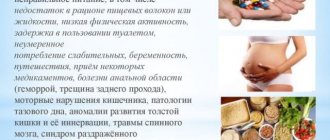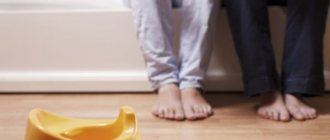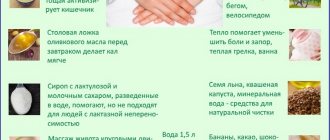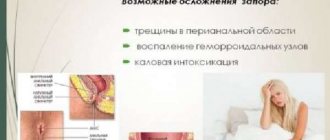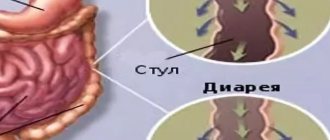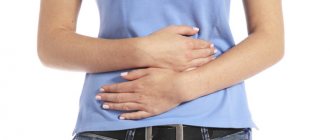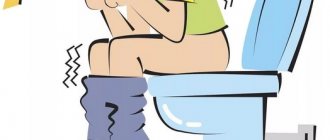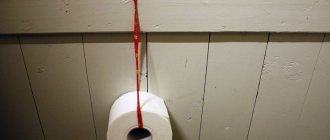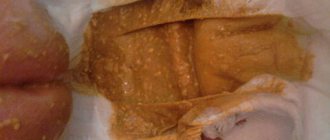The process of digestion in the human body takes place in several stages: breakdown in the stomach, separation into proteins, fats, carbohydrates in the small intestine, absorption of elements, removal of unnecessary substances. Defecation releases undigested food debris, dead membrane cells, and microbes that initiate fermentation and gas formation. The combined mass is called feces. Normally, the consistency is similar to toothpaste, smooth brown in color, 15-18 cm long.
Hard feces indicate disturbances in the process of digestion and metabolism in the body, causing pain and difficulty during bowel movements.
1.What are the dangers of an intestine clogged with feces?
If you play sports, eat a lot of foods rich in fiber and do not overuse protein foods, then you can follow an example. Meanwhile, the modern rhythm of life and nutrition often lead to bowel movements occurring less than once a day.
When the contents stop moving and shrink, fecal stones form around a solid particle (berry seed, foreign body, gallstone). Since food moves slowly, it does not have time to be digested, but begins to rot and ferment.
Most toxins are formed during the breakdown of protein foods. Being absorbed and entering the blood, it clogs the liver, which is obliged to deactivate them. If this happens regularly, over time not only it, but also all body systems can no longer cope. The blood pH shifts to the acidic side, microcirculation in all organs and tissues is disrupted.
Constipation and protein foods, especially those with a lot of smoked foods, are considered one of the possible causes of colon and rectal cancer.
Under the influence of smoke, carcinogens are formed in meat; they stagnate in the intestines, causing cells to mutate and cancer cells to appear. The longer and more often carcinogens act, the more such cells there are. Over time, the immune system can no longer cope with them.
Acute constipation
The acute form of constipation includes those conditions when a hardened mass of feces gets stuck in the intestines, and its exit is completely stopped.
The following symptoms are characteristic of this type of problematic stool:
- discomfort is felt in the rectal area;
- there is a feeling of fullness in the lower abdomen;
- there is no emptying at all;
- urge to evacuate that ends in nothing.
Often, hard stool is accompanied by a pathology when constipation with hard feces is caused by incomplete release of feces accumulated in the intestines. The process is quite painful, since previously stuck feces are difficult to pass through the intestines, they damage its walls and lead to rupture of the anus.
If measures are not taken to soften hardened excrement before emptying, then the consequences of such constipation can be hernias, rectal prolapse, and the appearance of hemorrhoids.
2.Causes of constipation
Main causes of constipation:
- low fiber diet,
- drinking insufficient amounts of fluid,
- weak physical activity,
- pregnancy in women,
- obesity,
- diseases of the digestive system that impede the passage of food (tumor, hernia, ball of worms),
- rectal fissures or hemorrhoids,
- constant stress,
- spinal injuries.
Although the reasons are different, the symptoms are always similar. This is the absence of bowel movements for more than 48 hours, heaviness, bloating and discomfort in the abdomen, sometimes severe pain and cramps appear, especially when there is pressure on the intestinal wall from fecal stones. Symptoms also appear in other organs or systems: pale, unhealthy skin, frequent mood swings, depression, decreased immunity
I consider it my duty to provide a translation of the medical terms from the table into Russian:
- Anorectal - Relating to the anus and rectum.
- Hypomotor - caused by a decrease in motor activity of the colon.
- Dyskinesia is a series of involuntary movements that are a fragmentation of the usually smooth and controlled movements of the face and limbs.
- Pathogenic - pathogenic.
- Spastic - spasmodic.
3.How to cleanse the intestines of feces at home
3.1 How to quickly cleanse the intestines of feces with an enema
One of the most ancient methods of how to quickly cleanse the intestines remains an enema. In the era of night balls, it was important for women that their skin remained young and seemed fresh all night, and therefore home healers gave them deep cleansing enemas before each appearance.
And men sometimes abused the method: it is known that Louis XIV received more than two thousand enemas to improve his health. But it is better to do without an enema and cleanse the intestines of waste and toxins in more physiological ways, so as not to injure the intestinal villi and not disrupt its normal motility.
Procedure for administering an enema:
- Pour boiled room water into a 2-liter Esmarch mug. To force out the air, open the faucet. As soon as water comes out, close it.
- Hang the mug higher at head level on the hook
- Get on your knees with your elbows on the floor
- Carefully insert the ebonite tip from Esmarch's mug, lubricated with sunflower oil, into the anus
- Open the faucet
- Water will begin to flow into the rectum
- When all the water has poured out of Esmarch's mug, close the tap
- If your health allows, take the “Birch” yoga pose for a few minutes.
Try to be patient for 5-10 minutes and not go to the toilet. After the procedure, it is recommended to thoroughly wash the ebonite tip of Esmarch’s mug with soap, or better yet, boil it.
3.2 Watermelon, apples and berries
Before answering the question: “How can you completely cleanse the digestive tract?” — I’ll tell you about one observation. Every winter, my nephews’ constipation was treated with folk remedies and pharmaceutical drugs, they changed their diet and enrolled in various sports sections, and as soon as the raspberries ripened in the garden in the summer, everything went away on its own, the watermelon took over the baton, and the autumn apples finished.
In winter, almost nothing helped again: they gave kefir, vegetables and fruits, changed medications, even brewed medicinal herbs - and until the end of spring, the stomach and liver still worked worse.
So it’s better to start not with an enema or pills, but with proper nutrition and lifestyle.
And by and large, you need to start and finish cleansing your intestines with proper nutrition. This is a long process, but there is no other way. If for years we ate everything in a row and without measure, clogged our intestines with waste and toxins, then we won’t be able to get rid of all this quickly, with the help of a magic pill.
Can you imagine if all this nasty stuff comes out at once? Lethal outcome is guaranteed, and this option does not suit us. Therefore, to the question:
- I answer clearly and clearly:
“The most effective method of cleansing the intestines is proper nutrition!”
The effects of the foods I've talked about are easy to explain: watermelon and apples are rich in fiber, which is a natural laxative. And some berries (raspberries, strawberries, wild strawberries) have small seeds, which additionally irritate the intestinal wall in order to quickly come out of it and not be digested. I can add that among food products with a laxative effect you can include in your diet:
3.3 Kefir
I will especially focus on kefir: the lactic acid bacteria that are found in it, in small quantities, have a laxative effect, and with prolonged fermentation and the accumulation of enzymes, they have a fixing effect. So I recommend drinking only fresh kefir for cleansing, and not one that was made more than 3 days ago.
Where does fecal impaction form and why does it happen?
Fecal impaction can occur in any part of the large intestine. Usually they are formed directly “at the exit” of the body, in the rectum. Fecal impaction is a direct consequence of chronic constipation. The main factor influencing its development is the habit of waiting until the disease goes away on its own, without doing anything about the accumulation of feces.
Other reasons why fecal impaction forms are as follows:
- consuming large amounts of food at one time;
- an abundance of smoked, fried and fatty foods in the diet;
- congenital or acquired disorder of the shape of the rectum;
- disturbances of tone and peristalsis of the large intestine;
- psychological reasons.
Psychological reasons are a separate matter. Fecal impaction forms in people with hemorrhoids and anal fissures due to banal fear. It seems to the patient that if he pushes hard, trying to “push” feces out of himself, this will provoke a deterioration in the condition of the anorectal area. The hemorrhoids will swell even more, bleeding will increase, so the person holds back all the urges to go to the toilet until the disease recedes. But this only leads to new complications. In case of hemorrhoids, it is better to give an enema or suppositories in time than to lead to fecal stones.
Other psychological factors behind the formation of traffic jams are: depression, serious psychological problems, mental illness. In this state, a person does not follow the rhythms of bowel movements at all. Naturally, the occurrence of fecal impactions cannot be avoided.
Fecal impaction in a child may occur due to his love for persimmons. Paradoxically, this fruit is the leader in clogging the intestines with its undigested waste. If your baby loves tart, astringent persimmons, then be careful, because he is at risk.
Postscript with Inspector Warnicke
For those who want to relax and at the same time activate cerebral circulation, which is no less important for our health than cleansing the intestines, I suggest trying to solve detective riddle stories together with Inspector Warnicke. Meet me.
I started publishing these stories on July 04, 2020 “HERE” and continued on July 06, 2020 “HERE”
Fecal stones (or coprolites) are dense formations that form in the intestinal cavity from the remains of undigested food. For their occurrence, stagnation of feces in the digestive system is necessary, which can occur against the background of constant constipation, disturbances of intestinal motility and other diseases.
Enema for hardened stool
How to quickly soften stool at home without using laxatives? The best way to soften feces and directly affect the intestinal muscles is an enema. This cleansing method is quick-acting and guarantees complete emptying.
When excrement hardens and blockages form, the enema solution is made based on oils, such as:
- olive;
- pumpkin;
- linen;
- glycerin;
- sea buckthorn, etc.
Oil enemas are characterized by a slow action. You should wait no earlier than 8–10 hours to have a bowel movement after administering the mixture. But their use guarantees a change in the fecal structure and prevention of damage to the walls of the intestines and anus.
Before introducing the solution into the intestinal cavity, it is necessary to warm it to a temperature of 36–37 degrees. Warm oil will relieve cramps and allow feces to dissolve faster. Once saturated with oil, excrement becomes slippery and soft, making it quickly and easily move through the rectum to the exit.
An enema should not be given during pregnancy and this method should be used with caution if you have hemorrhoids.
How to soften stool with oils without using an enema? Any of the vegetable oils can be added to prepared foods. This allows you not only to get rid of constipation, but also to prevent its occurrence. If you have frequent problems with bowel movements, doctors recommend taking oils to prevent hardening of feces.
However, vegetable oil should be used with caution, as large amounts can cause severe diarrhea and negatively affect liver function. The permissible safe dose per day is 4–6 drops.
Symptoms
Small fecal stones may not cause any discomfort to the patient. Often such disorders are detected during a random examination for other possible intestinal pathologies. Symptoms appear later when the stones enlarge and partially block the intestinal lumen.
Partial obstruction of the intestinal lumen
In this case, a characteristic clinical picture of the disease arises:
- flatulence, bloating;
- colic-type abdominal pain - strong but short-term attacks of discomfort;
- strong odor from the mouth;
- constant constipation;
- change in the nature of the stool - the stool becomes darker, impurities of blood or mucus may be detected;
- general symptoms of intoxication are headaches, general weakness, irritability, loss of appetite.
Complete closure of the intestinal lumen
The extreme stage of the disease is considered to be obstructive intestinal obstruction. The condition occurs when the intestinal lumen is completely blocked by fecal stone. There is a worsening of the symptoms of the pathology. The clinical picture of obstructive obstruction includes:
- complete retention of gases and stools;
- repeated vomiting that does not bring relief;
- severe cramping pain;
- severe intoxication of the body - fever, chills, headaches, severe weakness.
Reasons for education
- poor nutrition – a large amount of preservatives, fatty acids and other harmful substances in the dishes consumed;
- uncontrolled use of certain medications - hormonal drugs, antibacterial agents, antacids, analgesics;
- constant psycho-emotional arousal, frequent stressful conditions;
- physical inactivity, low level of physical activity;
- violation of water and electrolyte metabolism in the body;
- entry into the digestive system of foreign bodies - chewing gum, small fruit seeds, etc.;
- atonic states - decreased peristaltic activity of the intestine;
- the formation of stones in the gall bladder and their penetration into the gastrointestinal tract.
How to get rid of fecal stones?
Enema
Enema is one of the effective ways to combat fecal stones. The procedure can be carried out in a hospital or at home. This is acceptable if the patient’s condition does not require urgent medical intervention, that is, there are no signs of complete obstruction of the intestinal lumen.
It is recommended to start treatment with a cleansing enema. To do this you need:
- Prepare a solution for cleansing - it is advisable to use a herbal decoction, which is prepared at the rate of 1 tablespoon of herbal mixture (chamomile, dill, celandine) per 0.5 liters of boiling water.
- Leave the resulting solution for about half an hour.
- Pour it into a syringe.
- Place the patient on his side, with his legs pulled toward his stomach.
- Insert the tip of the syringe into the patient's anus.
- Slowly introduce the solution into the intestines.
- Wait 10-15 minutes, after which the patient should go to the toilet.
If a conventional cleansing enema is ineffective, a more extensive intervention is performed - a siphon enema. It involves repeated administration and removal of fluid. 1-2 liters are administered at a time, the total volume of solution used for the procedure is 15-20 liters.
Hydrocolonoscopy
Hydrocolonoscopy is a therapeutic intervention, which is a type of enema therapy. The procedure is carried out using special dialysis equipment, which allows for flow-through rinsing of the intestines with water or special solutions. The total volume of liquid used is approximately 20-30 liters. The duration of each session is only 20-40 minutes. The intervention can be performed on an outpatient basis; hospitalization of the patient is not required.
Repeated colon cleansing allows you to remove small fecal stones from the digestive system. Colon hydrotherapy is carried out in several sessions, the interval between which is 2-3 days. Repeated procedures ensure that all coprolites are removed from the intestines.
Laxatives
Laxatives are a fairly effective method of combating coprolites, but they have a number of limitations. Drugs from this group may have different mechanisms of action. This can affect the patient's condition and even worsen the course of his disease.
In addition, in most cases, the use of laxatives is accompanied by the removal of important electrolytes from the body, which also has certain consequences. For example, a decrease in potassium content worsens the course of cardiovascular pathologies.
Therefore, to prevent adverse consequences, self-medication with laxatives is strictly prohibited! The medications should be selected by the attending physician after a complete examination of the patient.
| A drug | Group of laxatives | Reception features |
| Castor oil | Agents that stimulate peristalsis | 1 tablespoon twice a day, it is possible to use oil in capsules |
| Sodium sulfate | Drugs that help stretch the intestinal walls | In enemas 120 ml per procedure |
| Lactulose | Stool thinners | 2-3 tablespoons of the product in the first 3 days, after – 1-2 tablespoons |
Diet
The diet for coprolites should comply with several general principles that help restore normal peristalsis. These include:
- Fractional meals. You need to eat 5-6 times a day, in small portions.
- Gentle nutrition. Food should cause minimal discomfort to the intestines. This applies not only to the chemical composition of products, but also to temperature characteristics. Too hot foods or drinks, as well as too cold foods, are prohibited.
- Balanced diet. The patient's diet should include sufficient amounts of nutrients, vitamins, and electrolytes.
Using special means
The fastest method of normalizing stool consistency is the use of medications. So, for example, special laxatives allow you to painlessly empty the intestines not only by activating peristalsis, but also by softening the excrement.
However, it is worth remembering that taking laxatives when fecal stones form should be done with caution. Means that have an immediate effect cause stool within a short time, but do not have time to change the structure of the accumulated masses. Therefore, emptying after them is accompanied by ruptures of the anus and pain.
For long-term constipation, it is best to take a laxative, a stool softener that has a slow effect. These emollients act at the level of the small intestine. They reduce the fluid loss of accumulated feces and ensure their free and painless exit.
In addition to tablet form, laxatives are also available in the form of suppositories and rectal gels. Thus, suppositories that soften stool and gels allow you to quickly and easily go to the toilet already 15–20 minutes after their use. Such drugs include:
As for suppositories, their use is prohibited in case of exacerbation of hemorrhoids, the presence of an inflammatory process in the colon and uterine bleeding.
We advise you to read: what nutritional supplements should you take for constipation?
Prevention
The basis for preventing the formation of coprolites is proper nutrition. A diet containing enough fiber and nutrients, proper distribution of food between meals is the key to normal intestinal motility.
Timely treatment of intestinal pathologies is of particular importance in the prevention of coprolites - mandatory consultation with a doctor in the presence of constant constipation.
The intestine is the largest organ in the complex human body. Thus, a complete colon occupies an area of 200 m² and reaches a length of 2 meters. The thin part of the suction organ of the gastrointestinal tract has a longer indicator of 8 meters. The intestines carry out the process of absorbing nutrients that come from food. This organ also helps the body get rid of waste products. Violation of the cleansing function entails dense blockage of the intestines and generates the development of various kinds of pathologies (including due to feces).
Possible consequences
The consequences of trouble include:
- Cracks that become inflamed when infected or bacteria enter.
- Pain syndrome, leading to loss of strength and depression.
- Toxin poisoning can provoke constant migraines with increased blood pressure.
- Haemorrhoids.
- Colitis.
- Reflux enteritis (inflammation in the upper gastrointestinal tract).
- Severe distension of the intestine.
The greatest danger is posed by harmful substances that are excreted by feces. If it lingers in the body for more than a day, toxic poisoning is inevitable - microbes penetrate the blood and spread throughout all organs. This cycle is repeated several times, depleting the body .
Stagnant masses in the intestine provoke the creation of carcinogenic microflora. It is in this environment that malignant cells multiply best, threatening tumors. Untimely treatment of constipation or ignoring the unusual consistency of stool can cause intestinal cancer.
It is especially important to pay attention to metabolic disorders during pregnancy and after childbirth. During this period, a woman’s immunity is weakened and is not always able to detect and defeat pathogenic cells.
Causes of pathological intestinal disorders
The normal functioning of the absorptive organ of the gastrointestinal tract is influenced by a large number of factors, both external and internal. But where does the original source of the development of illnesses come from? Nikolai Amosov argued: “All human illnesses and misfortunes arise from poor nutrition. We are what we eat." There is a great deal of truth in this expression. After all, preservatives, nitrates, pesticides and various heavy metals settle in the sections of the colon. Excessive accumulation of these structural components affects the normal metabolism and functioning of cells and tissues. A person causes himself a lot of problems by eating on the go and chewing food poorly. This can also include abuse of alcohol and various medications. The causes of slagged and clogged intestines are as follows:
- High calorie foods.
- Food that has been prepared through prolonged heat treatment (canned food, juices, casseroles).
- Insufficient amount of fluid in the human body.
- Weak motor activity (lying down lifestyle).
- Psychological disorders and stressful moments.
The above reasons can be safely supplemented by unsystematic bowel movements. Healthy people always monitor the frequency of this “ritual” and control the physiological activity of the body. Medicine says that the most favorable time to visit the toilet is early morning and evening. In the absence of a clear pattern of defecation, feces stagnate in the bends and folds of the suction organ. The malignant consistency gradually thickens and transforms into fecal stones. Thus, the nerve endings of the intestine stop promptly responding to the pressure of decay products. In practice, a person does not feel the urge to go to the toilet. What follows is a closed cycle. Poor quality nutrition develops into clogging of all parts of the intestines, which leads to atrophy of special impulses. As a result, chronic atony and intoxication are formed, which complicates the stagnation of the absorption organ. It becomes impossible to go to the toilet.
Experts say that the total mass of stones (feces) in the intestines can reach from 3 to 5 kg. Both thin and fat people can equally face this situation.
How to prevent hardening of stool
Most often, fecal hardening occurs due to intestinal dysfunction. To ensure that feces do not have time to accumulate and are passed out regularly, it is necessary to ensure that bowel movements occur daily.
If you have a problem intestine, you must follow these recommendations:
- the diet should be filled with foods that soften the stool;
- the consumption of flour products should be reduced to a minimum, baked goods consumed should be stale;
- You must drink at least one and a half liters of clean water per day;
- exclude spicy, fried, fatty foods from the diet;
- eat more fresh fruits and vegetables (with the exception of legumes, pears, grapes and persimmons);
- the diet should contain dried fruits (especially dried apricots and prunes);
- The daily diet must include boiled beets with vegetable oil;
- The day should start with light exercise.
If constipation is associated with a gastrointestinal disease, prevention should consist not only of proper nutrition, but it is also necessary to get rid of the underlying cause that leads to intestinal dysfunction. This therapy should be carried out exclusively under the supervision of a specialist and with the use of medications.
Stagnation and its symptoms
Finding out that the intestines are clogged is quite simple. Hardened feces over time stretch the digestive organ and give it a swollen shape. Naturally, human health will be at risk. After all, the compressed area of the wall of the suction organ will be significantly limited in blood supply. A large number of toxins will dynamically penetrate into the lymphatic structures and circulatory system.
The variety of intestinal pathologies is quite large. Disorders are directly related to the place that is pinched by stones. Serious damage to the mucous membrane leads to the formation of chronic colitis, injury to the walls leads to the development of hemorrhoids and varicose veins. If fecal stones come into contact with the intestinal walls for a long time, there is a risk of the formation of polyposis and cancerous tumors.
The elongated and stretched shape of the intestinal walls completely neutralizes the work of the nerve endings of the absorption organ. The urge to stool is completely absent due to impaired intestinal motility. Symptoms of stagnant intestines (including due to feces) are as follows:
- Complete apathy towards life + chronic feeling of fatigue.
- Severe dizziness, headache.
- Painful abdominal distension + bloating.
- The presence of white plaque on the tongue and black plaque on all teeth.
- Pungent and unpleasant odor from the mouth.
- The skin is pale in color.
- Puffiness around the eyes and the presence of dark bags.
- Prolonged insomnia + increased sweating.
- Cellulite in combination with an enlarged belly.
- A large number of diseases that are associated with the nasopharynx.
- Skin rash (allergies) + hair loss.
It is worth noting that the above signs of a pathological disorder are not found in their pure form in practice. Symptoms of slagging are complex. A qualified specialist will be able to establish an accurate diagnosis if he finds even 2 criteria for the disease.
Decaying feces contribute to the formation and development of an alkaline environment, which is an ideal source of pathogenic microflora. Mold is the result of a decay process. These structural substances settle on the tongue and teeth in the form of the well-known plaque. If a sick person ignores measures to combat intestinal disorders for a long time, the mucous membrane gradually becomes deformed. In difficult cases, it is almost impossible to restore it.
The process of intestinal restoration is based on the principle of complex actions. The patient should promptly optimize the diet, supply the body with vitamins in the required quantities (group A, C) and thoroughly cleanse the intestines.
Science has established that the content of microflora is directly related to human nutrition. Thus, plant foods promote the proliferation of beneficial bacteria. Microorganisms clearly maintain a balanced state in the sections of the large and small intestines, help improve immunity and completely suppress fermentation.
Cleansing techniques
The entire methodological apparatus can be divided into artificial and natural types.
Artificial cleaning option:
- Laxative medications (including for fecal stones). You should not abuse medications. Otherwise, the intestines will become lazy, and the person will be required to take special medications constantly.
- Hydrocolonoscopy is a deep cleansing of the colon using water. The liquid thoroughly irrigates the inner surface of the suction organ. This procedure is performed under the strict supervision of qualified specialists who perform a special abdominal massage. In this way, the process of separation of feces from the intestinal walls is stimulated. At the end of the therapeutic course, the patient is prescribed medications that optimize the microflora.
- Conducting an enema. This effective remedy is the most popular cleaning mechanism. The solution infusion device affects the separation of feces and the formation of intestinal patency. But this device is not always advisable to use. There is a whole list of contraindications. This is especially true when the patient experiences symptoms of an acute abdomen (chronic ulcers, systematic colitis, kidney stones, appendicitis). You should also refuse the procedure if the patient has recently undergone surgery, is addicted to alcohol or drugs, and suffers from chronic illnesses. Doctors do not recommend giving enemas to pregnant women or during menstruation.
Natural colon cleansing methods include:
- Regular bowel movements. Just form the habit of systematically visiting the toilet at a set time. In the medical literature there is information that a person needs to lightly stroke his stomach in the morning (clockwise) + drink boiled water in measured sips + do 10 squats.
- A rational and balanced diet is very useful for normalizing the functioning of all parts of the intestines. In such cases, nutritionists focus on eating the Panicle salad (cabbage, carrots, beets, vegetable oil). Drink kefir in the evening, eat grapefruits and oranges 250 g/day.
- Use of healing mixtures. The folk recipe is replete with a large abundance of decoctions and tinctures, which have been successfully tested in action. Thus, dried fruits, which are soaked in hot water and carefully scrolled through a meat grinder, are very popular. It is recommended to add 1 tbsp to the mixture. l. honey and 25 ml aloe juice. A homogeneous mass can be successfully spread on bread or simply consumed with warm water (strictly 30 minutes before a meal).
If you use the above methods of cleansing the intestines (artificial and natural), you can achieve good results and significantly improve the condition of the digestive organ. Thus, the motor activity of the intestine will be optimized. A systematic cleansing process eliminates all manifestations and consequences of slagging. The overall health of the person will improve significantly. Procedures must be performed in consultation with a doctor.
Source: ozdravin.ru
Symptoms of intestinal obstruction
Intestinal obstruction is a pathological syndrome that is associated with disruptions in the gastrointestinal tract.
Patients with acute intestinal obstruction often make dietary errors that correlate with peristalsis and diarrhea. This is especially true for children. Lifting heavy weights, complications after surgery, gynecological diseases - all this can cause digestive upset. The disease is accompanied by sudden cramping pain in the stomach area.
A thorough diagnosis of the intestines can give a clear answer to the question of the cause of obstruction. This could be a tumor, a narrowed lumen in the intestine, a large presence of fecal stones and other foreign elements. Intestinal blockage by foreign bodies is quite rare in practice. Unfortunately, gallstone disease can cause complete blockage of the small intestine. This process can be observed due to muscle spasm. The patient experiences a gag reflex, prolonged stool retention and a state of shock.
Intestinal blockage by worms most often occurs in children. Roundworms create a dense ball and carefully block the intestinal lumen. Clinical symptoms develop slowly and progressively. Sometimes you can feel a lump through the abdominal wall. In this case, the doctor prescribes a special course of treatment.
In medicine, there are frequent cases of intussusception (tumor progression) and volvulus. Twisting of the digestive organ (including the mesentery) around an axis is a serious form of strangulation-type obstruction. Volvulus is quite often observed in the small, sigmoid and cecum. This promotes the accumulation of fecal stones.
During pregnancy and after childbirth
Bearing a fetus is accompanied by changes in hormonal levels, as a result the tissue structure changes, the muscles of the uterus and the nearby intestines relax. First of all, this is necessary to keep the fetus in the womb and reduce the risks of premature birth.
There are other provocateurs of defecation disorders.
This:
- the predominance of the hormone progesterone, which relaxes peristalsis
- compression by the growing uterus;
- psychological state of fear of premature birth;
- fear of pushing;
- chronic diseases of the endocrine and vascular system that worsen during pregnancy;
- a sharp change in dietary preferences - you often crave pickled, salty, sweet, fatty foods;
- physical inactivity in later stages, which is provoked by weight gain.
Often after childbirth the problem worsens, especially during breastfeeding. The woman dramatically changes the menu, fiber consumption decreases, since many foods cause allergies in the baby. Lack of sleep and fluid loss further aggravate the situation.
If the birth took place by caesarean section, pain in the internal organs causes fear of going to the toilet. The woman is afraid that it will be even worse, the stitches will come apart, so she gets used to holding back her attempts . In the maternity hospital, it is difficult for her to adapt to someone else’s toilet, she is waiting for discharge, during this period the intestines atrophy, and the ability to store feces for a long time appears.
If altered stool continues for more than 3 days, urgent prevention of constipation is necessary. Delayed treatment in 80% of cases causes the development of intestinal diseases, including in children.
The answer to the question of how to soften stool during constipation depends on the main cause of the appearance of such a pathological condition and its neglect. Most often, you can correct the situation yourself at home, but sometimes you may need to go to a hospital for treatment. Therefore, before self-medication, it is better to consult a specialist.
System of measures for intestinal slagging
Cleaning should be based on the principles of integrity and consistency. First of all, the intestinal microflora must be softened. Only after this can you begin to eliminate harmful elements that are concentrated in parts of the colon.
The variety of procedures for recreating the cleanliness and microflora of the intestine is quite large. The most important action is the process of restoring pH balance. The level of acidity is directly related to the subtleties of chemical reactions. Next, you need to pay attention to the normalization of peristalsis of the intestinal walls, because fecal stones intensively stretch the absorption organ of the gastrointestinal tract. After this, the intestines will need to be brought back to normal shape. Restoration must be done comprehensively.
At the end of the rehabilitation period, the patient will need to optimize the microflora of the colon. This solution will have a beneficial effect on the state of the entire immune system, normalizes the warm-water characteristics of the digestive organ and its energy-forming functions.
Can constipation lead to complications?
If you adhere to the right lifestyle, you can avoid many digestive problems.
A sedentary lifestyle often leads to constipation. Therefore, you need to move a lot and walk in the fresh air. For the digestive system to function normally, morning exercises are quite enough. Breathing exercises and abdominal massage are also useful. Active hobbies and pets will help you move more.
In order for the stomach to function normally, it is recommended to eat food at the same time. You should start your morning with a glass of warm water to cleanse your digestive system of food debris.
After long-term drug treatment of pathologies in the intestines, it is recommended to take medications with probiotics that restore the intestinal microflora.

